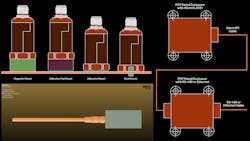How to Design a Good Vibration Sensor Enclosure (Part 3) (Download)
Based on the simulation and analytical results presented in Parts 1 and 2, a cylindrical enclosure will perform best for housing a single-axis ADXL1002 MEMS sensor with 21-kHz resonance. The MEMS sensor axis of sensitivity should be oriented to take advantage of the cylindrical enclosure’s first natural frequency performance in the z-axis.
The simulation models presented so far have excluded connector choices and their influence on the natural frequencies of the enclosure design. Figure 1 shows an M12 4-wire connector, part number T4171010004-001 from TE Connectivity. This connector is IP67-rated for water and dust resistance and includes a .STEP file from TE that can easily be integrated into the enclosure design file. The connector can be used with an M12-to-M12 cable, such as the TAA545B1411-002 from TE.
